News
Dell Unveils New PowerMax Scale-Out Storage Solution and R940xa and R840 Compute Systems
At Dell Technologies World, Dell announced the latest additions to its compute and storage lines.
This morning (Tuesday, May 1) at Dell Technologies World, Dell announced the latest additions to its compute and storage lines.
On the storage front, Dell announced the latest incarnation of its VMAX scale-out storage solution, PowerMax. The PowerMax was designed from the ground up to support NVMe attached storage. In keeping with Dell's longstanding tradition, the PowerMax uses standard dual-ported NVMe drives, and supports NVMe over Fabrics (NVMe-oF), among other protocols. The PowerMax comes in two configurations, 2000 and 8000 (Figure 1). The PowerMax 2000 is capable of delivering up to 1.7 million IOPs and has 1PBe capacity with the possibility of scaling up to two PowerBricks (nodes). The PowerMax 8000, on the other hand, is capable of delivering up to 10 million IOPs, has 4PBe capacity and can scale up to eight PowerBricks.
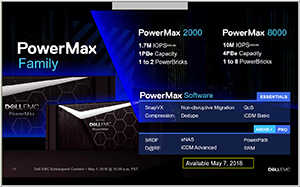 [Click on image for larger view.]
Figure 1. The PowerMax family. Source: Dell EMC
[Click on image for larger view.]
Figure 1. The PowerMax family. Source: Dell EMC
The software running the PowerMax will be available in two editions, Essentials and Pro. The Essentials edition offers such features as SnapVX, deduplication and QoS, while the Pro edition offers remote replication, PowerPath and SRM. Both the PowerMax software and hardware will be available May 7.
Although it won't be available in the initial release, the feature announced that I found most interesting about PowerMax is its support for NVMe SCM devices, which will dramatically reduce the latency of the array. Dell flashed a slide (
Figure 2) showing a 50 percent reduction in latency when NVMe SCM is used in the array.
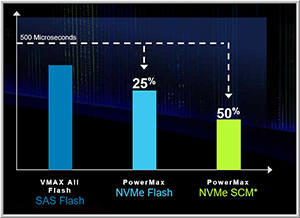 [Click on image for larger view.]
Figure 2. PowerMax Response time. Source: Dell EMC
[Click on image for larger view.]
Figure 2. PowerMax Response time. Source: Dell EMC
Dell also announced some important changes to XtremIO, its high-capacity all-flash enterprise storage platform. At half the price of the lowest priced system in its current lineup, XtremIO is trying to break into the mid-market with an entry-level system (Figure 3 ). XtremIO has new features added to its software that will dramatically reduce the amount of data sent over the wire when it does native replication. Dell also announced that future versions of XtremIO will support NVMe SCM.
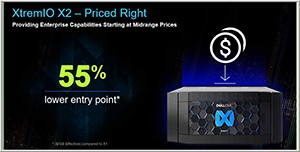 [Click on image for larger view.]
Figure 3. Entry-level XtremIO. Source: Dell EMC
[Click on image for larger view.]
Figure 3. Entry-level XtremIO. Source: Dell EMC
On the compute side, Dell announced R940xa and R840, two new four-socket systems in its PowerEdge server line, which will be available in Q2 2018. The R940xa (the "XA" stands for "eXtreme Aggregation" of data) is very interesting as it has a 1:1 CPU to GPU ratio, so it supports four GPUs (Figure 4). The most interesting spec on the R840 (Figure 5) is that it supports up to 24 NVMe drives and two GPUs. Both of these systems are designed to crunch through all the data needed for artificial intelligence (AI), machine learning and data analytics.
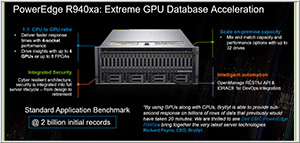 [Click on image for larger view.]
Figure 4. The PowerEdge R940xa Source: Dell EMC
[Click on image for larger view.]
Figure 4. The PowerEdge R940xa Source: Dell EMC
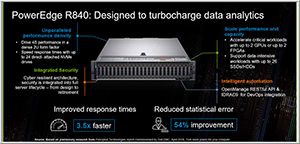 [Click on image for larger view.]
Figure 5. The PowerEdge R840. Source: Dell EMC
[Click on image for larger view.]
Figure 5. The PowerEdge R840. Source: Dell EMC
Dell previewed its new PowerEdge MX (the "MX" stands for Modular Architecture) line, which was specifically designed for addressing the needs in the software-defined datacenter (SDDC). One of the biggest challenges the SDDC faces is the sheer number of devices that enable an SDDC. The MX family addresses this issue by supporting the management of 8,000 PowerEdge devices, and doing so in an effective manner. These devices will offer three times more storage and five times more network I/O performance than their existing servers. The MX line (Figure 6) will be available in the second half of 2018.
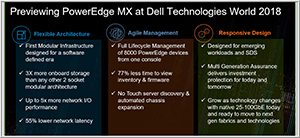 [Click on image for larger view.]
Figure 6. The PowerEdge MX. Source: Dell EMC
[Click on image for larger view.]
Figure 6. The PowerEdge MX. Source: Dell EMC
Dell also made two announcements of note around virtual desktop infrastructure. The first is a new Wyse client, the 5070. What caught my eye was the number of ports and slots that it has: 21. This includes multiple DisplayPorts, USB 3.1 Type C, and wired and wireless connectivity. It can be configured for multiple 4K monitors. Dell said that it's highly customizable and should fit in a large swath of end-user use cases. The client supports Citrix, Microsoft or VMware virtual desktop and runs Wyse ThinOS, ThinLinux or Windows 10 IoT Enterprise OSes. Dell did not quote a price, but did say that it offers greater performance and more options at a better price than its primary competitors.
To host the virtual desktops Dell EMC has expanded its VDI Complete Solutions offerings to include new features such as support for Dell EMC VxRail and vSAN Ready Nodes based on Dell EMC PowerEdge 14th generation servers. The solution also adds NVIDIA Quadro virtual Data Center Workstation (Quadro vDWS) software and NVIDIA Tesla P40 GPUs for professional, workstation-class workloads.
Although this morning was full of announcements, my main takeaways were that Dell has fully embraced high-performance NVMe Flash devices, and the company is future-proofing its products by enabling them for the even more performant NVMe SCM devices when they start to come online. Due to the amount of data in the next few years that will be produced and, as a result, that will need to be stored and analyzed in near-real time, this is a necessary step for Dell to take.
About the Author
Tom Fenton has a wealth of hands-on IT experience gained over the past 30 years in a variety of technologies, with the past 20 years focusing on virtualization and storage. He currently works as a Technical Marketing Manager for ControlUp. He previously worked at VMware in Staff and Senior level positions. He has also worked as a Senior Validation Engineer with The Taneja Group, where he headed the Validation Service Lab and was instrumental in starting up its vSphere Virtual Volumes practice. He's on X @vDoppler.